
Ed Poste's Homebuilt Carbon Fiber Recumbent Trike - 1/2007
This is one of the coolest looking trikes I've seen and as Ed says below, it can be replicated!
"A little over 3 years in the making, taking
2 1/2 years to develop design and build the molds (yes it can be
replicated).
This was one of the most challenging and interesting things I have done.
I learned a lot and especially came to appreciate the marvelous
characteristics of carbon fiber composite construction. Along the way I
came to understand the intricacies of steering geometries i.e. toe
in toe out, camber, rake, Ackerman effect etc. The trike is equipped
with hydraulic disc brakes, and a 27 speed derailleur setup."
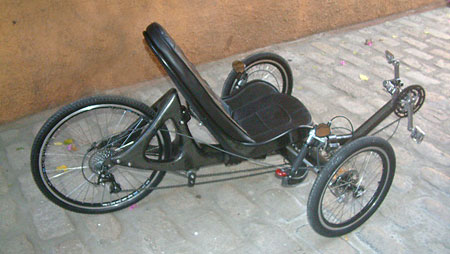
|
||
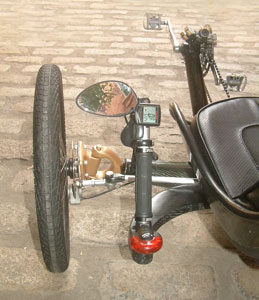 |
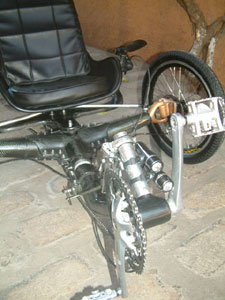 |
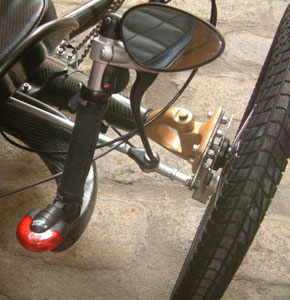 |
I asked Ed to elaborate on this project for us and here is his reply...
"Front wheels are 20" and rear is 26". The
ride is extremely comfortable as the seat is fully padded as can be seen
in the pics and the carbon bucket is suspended on 2 carbon leaf springs.
The handling is exactly to my liking and was partly due to luck. For the
steering I mocked every thing up in stiff cardboard for testing and it
just seemed right so I proceeded with making the molds. The linkage has
absolutely no slop and it appears that the Ackerman compensation is
good. I can do a reasonably brisk "U" turn in the width of a residential
street but have not actually measured turning radius and will do so this
weekend. The ratios for steering would be considered to be quick as it
takes only a small pressure rather than push to miss a pothole etc.
"My only problem and it is solvable is weight. A little background is in
order. I live in the Philippines and cannot buy carbon fiber locally
though epoxy is readily available. I had to order the fabric over the
Internet and have it sent in via UPS. I had never worked with carbon
fiber before and had difficulty in determining how many ply would be
necessary to achieve sufficient strength. I didn't want any part
failures that might cause an accident and would force me to remake a
part and waste the fabric so everything was overbuilt. NOW I know how
strong it is even with a layup yielding only 1/16" thickness. I have a
serious interest in seeing whether the design would attract a commercial
following (using low Philippine labor costs) and so now I am going to
start remaking parts but with less carbon fiber and hence less weight.
An example of this is the "Cross Frame". Take note of the picture that
illustrates how the front axle cones tie into the main frame tube
with an "X". The top and bottom of these parts are 1/4" and could
have been 1/8".
"Another area for improvement is the main tube. It is currently made of
6 parts i.e 3 parts X 2 for left half and right halves ( I wasn't real
sure about how long the wheelbase should be) so I gave myself the
flexibility of one adjustable angled tube for crankset plus one main
tube which is then captured in the rear triangular frame for the rear
wheel. It is now clear that the main tube and the rear triangular frame
should be one piece eliminating the clamping parts and the thru bolts.
You can't see them in the pics but they are under the seat and
constitute unnecessary weight. The wall thickness of the triangular
frame (which is hollow) is about right but it is clear that the main
tube could have been thinner and I'll adjust this as well for the next
one. Surprisingly the Kingpin/Steering knuckles though cast in aluminum
are quite heavy. These parts were made outside by a local foundry using
my plugs for the casting mold . The ONLY work not done by myself! I am
convinced these can be made in carbon fiber as well which will be a
substantial weight reduction. I am working on molds for them now. I am
not willing, at least for my trike, to reduce the foam in the seats as
at age 66 I want the comfort as well as the speed.
"I believe once I have made all of the changes the weight will be
approximately 32 lbs. This is not as light as some on the market but
includes pedals, front and rear lights, safety flag (installed after
pics) and a seat that is not only great looking but gives a very secure
"captured" feeling as compared to web strap seats. I envision my trike
as something that might attract interest because of its "elegance"
rather than just performance based on minimized weight...
"I would be very happy to have my e-mail included on your website as it
would be fun to share ideas with others and the Internet is my only
venue for that. I am certain that I own the only recumbent trike in the
whole country....and boy does it get attention while I whiz along!"
10/2009 Update - Ed wrote to follow up on this great trike. Here's the latest...
"Through your website I have received a lot of enquiries as well as compliments about my homebuilt Carbon Fiber Trike. In that original posting (Jan 2007) I referred to a lot of changes I thought could be made. Well 2 ++ years has gone by and I have incorporated all of the changes I felt were needed, including replacing aluminum steering kingpins with molded carbon fiber. I thought you and your readers might enjoy seeing what it looks like now.
Aside from rebuilding rear frame with fewer
parts I have added a front fairing and rear fairing which also functions
as a tool box. On the "dashboard" is a switch for the four LED light
assemblies as well as a receptacle for my cellphone. The cellphone
allows me to "Bluetooth" music to headphones and as well serves as a
speedometer and GPS track generator using "GPS CycleComputer" a free
software that works with my Windows Mobile Cellphone.(Sony Ericsson X1)"
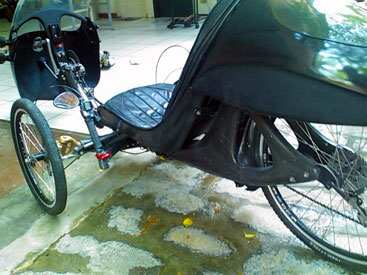 |
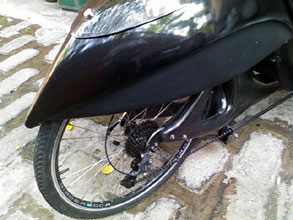 |
 |
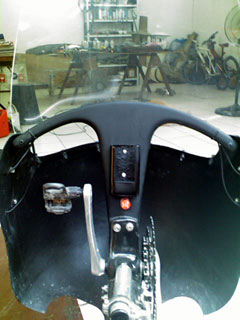 |
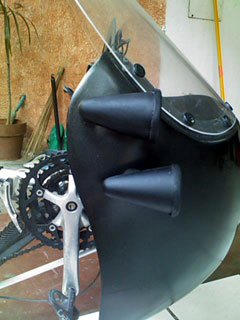 |